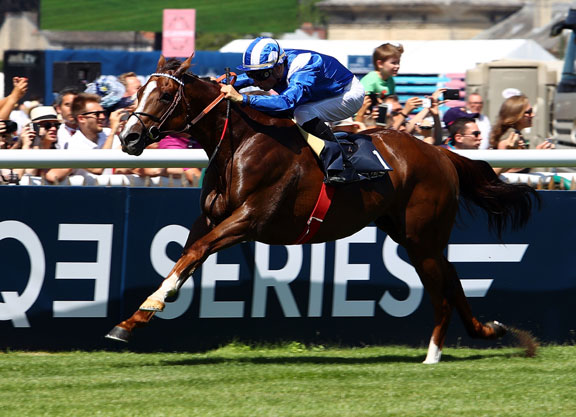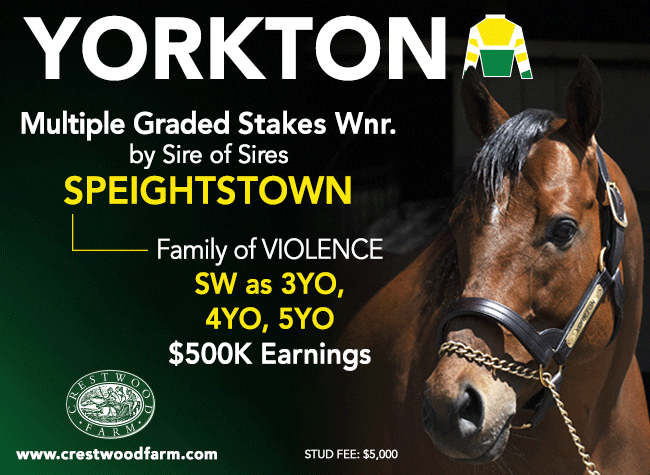By Emma Berry
At the close of 2018, Kitten's Joy (El Prado {Ire}) was crowned America's champion sire for the second time, an achievement made all the more remarkable by the fact that his reputation and progeny earnings have predominantly been hewn through his turf runners.
Kitten's Joy's other main accolade of last year was his son Roaring Lion being crowned European champion 3-year-old. Now about to take up covering duties at Tweenhills Farm & Stud, Roaring Lion is joined in the UK by Darley's G1 Eclipse S. winner Hawkbill, but they are two years behind Kitten's Joy's first son to stand at stud in Europe, the GI Breeders' Cup Turf Sprint winner Bobby's Kitten, bred by Ken and Sarah Ramsey and now under the care of Kirsten Rausing at Lanwades Stud.
The stallion ranks on this side of the Atlantic have been bolstered further with the retirement of Sheikh Hamdan's Taareef to Haras du Mezeray in Normandy, meaning that Kitten's Joy's three top-rated sons are all about to embark on a stallion career in Europe.
For Mezeray's Charles-Henri de Moussac, not only is the horse's arrival a welcome continuation of a long-running association with Shadwell, but also a return to a sireline for which, as the breeder of Artie Schiller, he has a soft spot. That particular son of El Prado won the GI Breeders' Cup Mile among his 10 victories and has stood at WinStar Farm in Kentucky since 2012 before staying in Australia for good prior to the 2018 Northern Hemisphere breeding season.
“Taareef is the first son of Kitten's Joy to stand in France,” says de Moussac. “For us of course it's interesting as we bred Artie Schiller, so it is a sireline that we like. Taareef was a good 2-year-old, a good miler, and this is what the market and the breeders want now. Kitten's Joy is starting to prove that he's a very good sire in Europe, with the likes of Roaring Lion and Hawkbill, so this is a good opportunity for French breeders to have access to his blood.”
Twice the winner of the G2 Qatar Prix Daniel Wildenstein on Arc weekend, Taareef, who enters stud at a fee of €6,000, was unbeaten in his two juvenile starts. Furthermore, he notched a trio of Group 3 contests under the tutelage of Jean-Claude Rouget and in 15 races across three seasons was only out of the first four on two occasions. So while de Moussac correctly identifies his pace and precocity as appealing to breeders, his credentials are given extra solidity by his consistency and durability. Bred by Dixiana Farms, the $675,000 Keeneland yearling is out of the five-time winner Sacred Feather (Carson City), herself a half-sister to a pair of Grade III turf winners.
Explaining Mezeray's link with Sheikh Hamdan's operation, de Moussac said, “We must thank Shadwell for giving us the chance to stand the horse in France. The story started with Muhtathir (GB), who started off at another stud, but we were very keen on his sireline because of Trempolino. We heard that there was a chance he could come back to France and when I went to look at the horse in Newmarket I fell in love with him. He's a beautiful horse, and thankfully Sheikh Hamdan decided to send him back to France. We also stood Naaqoos (GB), who we bred and sold at the sales, but then he came back to stand with us. So it's been a long association.”
That a link was made between two successful owner-breeders should come as no surprise. Mezeray is one of the most respected names in the French breeding industry and has been in operation since 1962 when Charles-Henri's father Paul first established his breeding operation across 230 hectares at Ticheville. The breeder of two Arc winners, Subotica (Fr) (Pampabird {GB}) and Trempolino (Sharpen Up {GB}), among a host of Group 1 winners, Paul de Moussac died in 1995, the year his son took over the running of the family business. Five years later, Trempolino, who was bred under Paul de Moussac's American banner Marystead Farm, was brought from his original base at Gainesway Farm to stand at Mezeray. He died there in retirement last March at the age of 34.
Muhtathir, who, as a son of Elmaamul, also represents the dwindling Sharpen Up line through Diesis (GB), is now the farm's elder statesman at 24 and is still covering a restricted book of mares.
“Muhtathir is so versatile,” says de Moussac. “He breeds good horses on the Flat and over the jumps, and his daughters are starting to breed some good horses, such as [Group 1-winning stayer] Holdthasigreen (Fr). He has been a very useful stallion for us and despite his age he was able to cover 40 mares last year.”
One of Muhtathir's best offspring, the multiple Group/Grade 1 winner Doctor Dino (Fr), is himself establishing a reputation as a classy dual-purpose operator from Haras du Mesnil, and both father and son were represented during the Christmas period by a Grade 1 winner over jumps.
Mezeray is also home to one of the unsung heroes of the French stallion ranks, Myboycharlie (Ire), who has supplied Group/Grade 1-winning fillies in Australia and America via Breeders' Cup heroine Sistercharlie (Ire), Caulfield Cup winner Jameka (Aus), high-class juvenile Peggy Jean (Aus) and the Beverly D S. winner Euro Charline (GB). Until last season, breeders could use the son of Danetime (Ire) for as little as €5,000 and he is still standing at a very reasonable rate even after a 50% price hike to €7,500.
“He has been successful and that means he has some big crops coming through and we have raised his price a bit this year,” says de Moussac.
Taareef is not the only new name on the Mezeray line-up this year as the farm is also now home to De Treville (GB), who started his stud career last year at Haras du Thenney. A dual winner and twice runner-up at Group 3 level, what the son of Oasis Dream (GB) lacks on the performance front, he more than makes up for in pedigree, as he was the first foal of Watership Down Stud's celebrated broodmare Dar Re Mi (GB) (Singspiel {GB}). In short, he's from one of the hottest families in the studbook.
“De Treville is owned by Rashit Shaykhutdinov, who is an important breeder in France with about 40 mares. He supported him last year with around 15 mares and he decided to move De Treville when Thenney had a change of management. Of course, there have been some good updates this year. It's a wonderful pedigree and he's a good-looking compact horse who should be given a chance,” notes de Moussac.
As a former Chairman of the European Breeders' Fund and current board member of France Galop, de Moussac is all too aware of the challenges facing the industry, with racing's shrinking income from betting naturally having a knock-on effect to breeding.
He says, “The big challenge for us now is to introduce a new generation to racing and breeding. In France we are a bit luckier as, first of all, we have a very good incentive programme, good prize-money and the owners' premiums, which encourage people to invest in French-breds.”
He continues, “Then there is the fact that some big breeders like the Aga Khan decided to keep some good stallions in France, whereas before they were going to Britain or Ireland. Now, new investors in France like Sheikh Joaan are also keeping stallions in France so I can see a big change even from 10 years ago when maybe 50% of the mares, maybe more, were going outside France to be bred. Now it's a real advantage to French breeders because when you send mares aboard there is an extra risk involved as well as cost. Economically for the French breeder it's a very good situation.”
With around 70 mares currently in residence–20 of the farm's own and the rest for clients–Mezeray's set-up has evolved in its 56-year existence from being essentially a private farm to offering a full range of breeding and sales services to fellow breeders.
“At the beginning it was just really owner-breeders and we had lots of horses in training but to make it more financially viable we had to become more commercial,” reflects de Moussac. “The challenge is to go on and to make sure we can keep reinvesting. The way the market is going you have to stay as close as you can to the top. There's a huge difference between the top 20% of the market and the very little below.”
Not a subscriber? Click here to sign up for the daily PDF or alerts.






